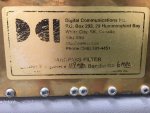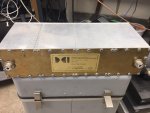I am getting intermod issues from 156-157 MHz and I have a question about dB reduction level needed to mitigate the issue. The primary signal is a nearby transmitter around 155 MHz that arrives at the scanner at a hefty -28 dBm. The other signals that mix with it are in pager band around 152 MHz and they arrive at around -80 to -60 dBm.
PAR offers a marine band filter that would give me ~40 dB attenuation for the 152 signals and negligible attenuation of the strong 155 GHz signal. That would make the pager band signals -120 to -100 dBm. The noise floor is around -105 dBm. Is dropping those pager band signals close to the noise floor sufficient for my situation? It seems like it may be enough but wanted to check before ordering the filter.
PAR offers a marine band filter that would give me ~40 dB attenuation for the 152 signals and negligible attenuation of the strong 155 GHz signal. That would make the pager band signals -120 to -100 dBm. The noise floor is around -105 dBm. Is dropping those pager band signals close to the noise floor sufficient for my situation? It seems like it may be enough but wanted to check before ordering the filter.




